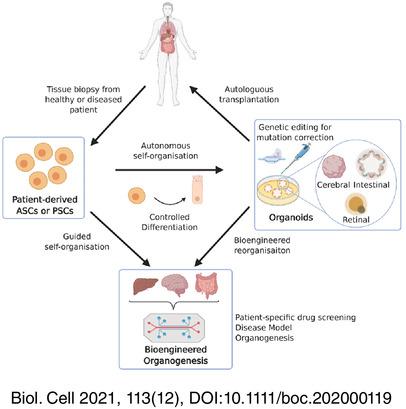当前位置:
X-MOL 学术
›
Biol. Cell
›
论文详情
Our official English website, www.x-mol.net, welcomes your feedback! (Note: you will need to create a separate account there.)
Bioengineering methods for organoid systems
Biology of the Cell ( IF 2.7 ) Pub Date : 2021-09-28 , DOI: 10.1111/boc.202000119 Jad Saleh 1 , Barbara Mercier 1 , Wang Xi 1
Biology of the Cell ( IF 2.7 ) Pub Date : 2021-09-28 , DOI: 10.1111/boc.202000119 Jad Saleh 1 , Barbara Mercier 1 , Wang Xi 1
Affiliation

|
Organoids have been widely used in fundamental, biomimetic, and therapeutic studies. These multicellular systems form via cell-autonomous self-organization where a cohort of stem cells undergoes in vivo-like proliferation, differentiation, and morphogenesis. They also recapitulate a series of physiological cell organization, complexity and functions that are untouchable by conventional bio-model systems using immortal cell lines. However, the development of organoids is often not easily controlled and their shape and size are yet fully physiological. Recent research has demonstrated that multiple bioengineering tools could be harnessed to control important internal and external cues that dictate stem cell behavior and stem-cell based organoid development. In this review, we introduce the current development of organoid systems and their potentials, as well as their limitations that impede their further utility in research and clinical fields. In comparison to conventional autonomous organoid system, we then review bioengineering approaches that offer improved control over organoid growth and development. We focus on the genetic editing tools that allow the program of build-in responses and phenotypes for organoid systems with enhanced physiological relevance. We also highlight the advances in bioengineering methods to modify cellular external milieus to generate desirable cell composition, 3D micro-architectures, and complex microfluidic systems. We conclude that the emerging biomimetic methods that employ multidisciplinary approaches could prevail in the future development of organoid systems.
中文翻译:

类器官系统的生物工程方法
类器官已广泛用于基础、仿生和治疗研究。这些多细胞系统通过细胞自主自组织形成,其中一组干细胞经历体内样增殖、分化和形态发生。它们还概括了使用永生细胞系的传统生物模型系统无法触及的一系列生理细胞组织、复杂性和功能。然而,类器官的发育通常不易控制,它们的形状和大小尚未完全生理。最近的研究表明,可以利用多种生物工程工具来控制决定干细胞行为和基于干细胞的类器官发育的重要内部和外部线索。在这篇综述中,我们介绍了类器官系统的当前发展及其潜力,以及它们的局限性,阻碍了它们在研究和临床领域的进一步应用。与传统的自主类器官系统相比,我们随后回顾了能够更好地控制类器官生长和发育的生物工程方法。我们专注于基因编辑工具,这些工具允许对具有增强生理相关性的类器官系统的内置反应和表型进行编程。我们还强调了生物工程方法在修改细胞外部环境以产生理想的细胞组成、3D 微架构和复杂的微流体系统方面取得的进展。我们得出结论,采用多学科方法的新兴仿生方法可能会在类器官系统的未来发展中占主导地位。与传统的自主类器官系统相比,我们随后回顾了能够更好地控制类器官生长和发育的生物工程方法。我们专注于基因编辑工具,这些工具允许对具有增强生理相关性的类器官系统的内置反应和表型进行编程。我们还强调了生物工程方法在修改细胞外部环境以产生理想的细胞组成、3D 微架构和复杂的微流体系统方面取得的进展。我们得出结论,采用多学科方法的新兴仿生方法可能会在类器官系统的未来发展中占主导地位。与传统的自主类器官系统相比,我们随后回顾了能够更好地控制类器官生长和发育的生物工程方法。我们专注于基因编辑工具,这些工具允许对具有增强生理相关性的类器官系统的内置反应和表型进行编程。我们还强调了生物工程方法在修改细胞外部环境以产生理想的细胞组成、3D 微架构和复杂的微流体系统方面取得的进展。我们得出结论,采用多学科方法的新兴仿生方法可能会在类器官系统的未来发展中占主导地位。我们专注于基因编辑工具,这些工具允许对具有增强生理相关性的类器官系统的内置反应和表型进行编程。我们还强调了生物工程方法在修改细胞外部环境以产生理想的细胞组成、3D 微架构和复杂的微流体系统方面取得的进展。我们得出结论,采用多学科方法的新兴仿生方法可能会在类器官系统的未来发展中占主导地位。我们专注于基因编辑工具,这些工具允许对具有增强生理相关性的类器官系统的内置反应和表型进行编程。我们还强调了生物工程方法在修改细胞外部环境以产生理想的细胞组成、3D 微架构和复杂的微流体系统方面取得的进展。我们得出结论,采用多学科方法的新兴仿生方法可能会在类器官系统的未来发展中占主导地位。
更新日期:2021-12-01
中文翻译:

类器官系统的生物工程方法
类器官已广泛用于基础、仿生和治疗研究。这些多细胞系统通过细胞自主自组织形成,其中一组干细胞经历体内样增殖、分化和形态发生。它们还概括了使用永生细胞系的传统生物模型系统无法触及的一系列生理细胞组织、复杂性和功能。然而,类器官的发育通常不易控制,它们的形状和大小尚未完全生理。最近的研究表明,可以利用多种生物工程工具来控制决定干细胞行为和基于干细胞的类器官发育的重要内部和外部线索。在这篇综述中,我们介绍了类器官系统的当前发展及其潜力,以及它们的局限性,阻碍了它们在研究和临床领域的进一步应用。与传统的自主类器官系统相比,我们随后回顾了能够更好地控制类器官生长和发育的生物工程方法。我们专注于基因编辑工具,这些工具允许对具有增强生理相关性的类器官系统的内置反应和表型进行编程。我们还强调了生物工程方法在修改细胞外部环境以产生理想的细胞组成、3D 微架构和复杂的微流体系统方面取得的进展。我们得出结论,采用多学科方法的新兴仿生方法可能会在类器官系统的未来发展中占主导地位。与传统的自主类器官系统相比,我们随后回顾了能够更好地控制类器官生长和发育的生物工程方法。我们专注于基因编辑工具,这些工具允许对具有增强生理相关性的类器官系统的内置反应和表型进行编程。我们还强调了生物工程方法在修改细胞外部环境以产生理想的细胞组成、3D 微架构和复杂的微流体系统方面取得的进展。我们得出结论,采用多学科方法的新兴仿生方法可能会在类器官系统的未来发展中占主导地位。与传统的自主类器官系统相比,我们随后回顾了能够更好地控制类器官生长和发育的生物工程方法。我们专注于基因编辑工具,这些工具允许对具有增强生理相关性的类器官系统的内置反应和表型进行编程。我们还强调了生物工程方法在修改细胞外部环境以产生理想的细胞组成、3D 微架构和复杂的微流体系统方面取得的进展。我们得出结论,采用多学科方法的新兴仿生方法可能会在类器官系统的未来发展中占主导地位。我们专注于基因编辑工具,这些工具允许对具有增强生理相关性的类器官系统的内置反应和表型进行编程。我们还强调了生物工程方法在修改细胞外部环境以产生理想的细胞组成、3D 微架构和复杂的微流体系统方面取得的进展。我们得出结论,采用多学科方法的新兴仿生方法可能会在类器官系统的未来发展中占主导地位。我们专注于基因编辑工具,这些工具允许对具有增强生理相关性的类器官系统的内置反应和表型进行编程。我们还强调了生物工程方法在修改细胞外部环境以产生理想的细胞组成、3D 微架构和复杂的微流体系统方面取得的进展。我们得出结论,采用多学科方法的新兴仿生方法可能会在类器官系统的未来发展中占主导地位。


























 京公网安备 11010802027423号
京公网安备 11010802027423号